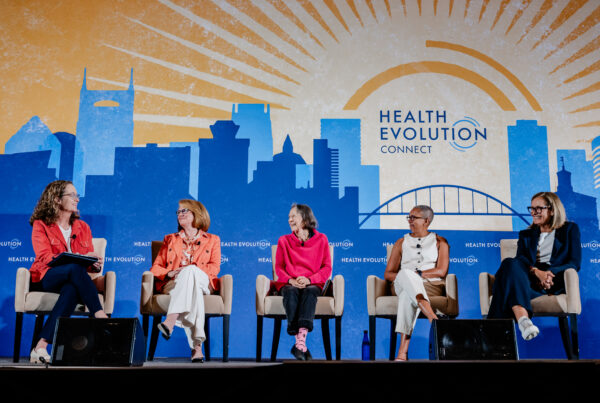Our most-read articles this year are not limited to COVID-19 coverage, though the pandemic certainly dominated the health care discourse as it did in other industries, too.
These articles dive into the surge in digital health funding and some of the challenges associated with those opportunities, examine how the industry witnessed more than a dozen hospitals enter into a joint data sharing and analytics arrangement, look at how health care encountered critical questions about terminology that is inhibiting advancements in health equity and examine a renewed commitment to alternative payment models. We also spoke with CEOs and other thoughts leaders on the frontlines working to reduce disparities, drive digital transformation, and emerge post-pandemic as a more affordable, equitable and resilient health care system than the one that has been overextended and overwhelmed since early 2020 and throughout 2021’s entirety.
Here are the most-read Health Evolution articles of this year:
Is the concept of social determinants of health inhibiting progress toward health equity?
Despite positive intentions to understand social determinants for improving outcomes in underserved communities, the mindset may be defeatist and enables the status quo in which the U.S. health system is underperforming for certain groups of people. “We have to call social determinants of health what it is — poverty and racism — and speak in plain English as opposed to creating these terms of art,” says Sachin Jain, MD, President & CEO, SCAN Group and Health Plan.
Truveta CEO Terry Myerson’s bold goals for data driven health care company
The long-time Microsoft executive discusses Truveta, a collaboration initially launched with 14 large health systems. He spoke with Health Evolution on why he’s optimistic about the company’s plans to generate clinical insights through an AI-driven data platform. “It was clear the world needed this Truveta project to exist,” he says. “We need a data set like this so we can take care of patients better.”
When trauma makes time travelers out of health care workers
Guest contributor Tosan O. Boyo, Senior Vice President of Hospital Operations at John Muir Health, reflects on health workers owning their trauma through the pandemic and the anniversary of George Floyd’s murder. “We were bombarded with trauma at work and suffered the fallout at home. Some drilled into cracked foundations of marriages, some scuffled with virtual learning for kids, some suffered isolation from communities and yet we all strived to remind everyone that COVID-19 was not political.” Boyo writes.
What’s driving the surge in digital health funding?
To better understand what health care leaders should make of the money being poured into digital health, we interviewed five experts representing five different areas of the health care system. “There’s a wholly different level of familiarity and comfort with remote models from a patient and a clinician and hospital administration perspective. From a funding standpoint, that has prompted both entrepreneurs and VCs to accelerate their plans and expectations for going public and scaling commercial success in the marketplace,” says Sukanya Soderland, Chief Strategy Officer and Senior Vice President for Blue Cross Blue Shield of Massachusetts
See also: Part 2: Will digital health funding boom or bust? Part 3: In a competitive digital health landscape it’s hard to stand out
Increasing vaccine uptake in diverse communities
This working guide for CEOs developed by Health Evolution Forum Fellows the Roundtable on Community Health and Advancing Health Equity in partnership with Change Healthcare offers 10 recommendations for leaders to increase vaccine confidence and accessibility in the diverse communities they serve, which have been negatively impacted by the ongoing pandemic.
CityMD founder Richard Park on improving care for Asian Americans in NYC
With his latest venture, Rendr, the entrepreneur is working to apply the same self-advocacy, scalability and standardization concepts that worked well to improve care for Asian American populations. “We can’t wait for someone to solve problems in our communities. We have to fix it. Let’s do it ourselves. It takes self-responsibility and advocacy,” Park says.
Northwell Direct CEO takes aim at the traditional model for health benefits
Nick Stefanizzi discusses why employers are tired of the traditional model of paying for benefits, why direct contracting is ripe for disruption and what Northwell Direct is doing in the space. Traditional payers “use a lack of transparency and control of data as a defense mechanism. It’s a shame because at the end of the day, the data belongs to the employer. It’s on their workforce and they have a right to it,” Stefanizzi says.
Geisinger’s Karen Murphy on the integrated health system’s next step with digital health
Murphy explains the launch of a new care delivery model, powered by remote patient monitoring. “We’ve been at this for probably the better part of almost two years of evaluating what we’re currently doing and then developing a vision for the future,” says Karen Murphy, Executive Vice President and Chief Innovation Officer, Geisinger. “We will use the patient-reported outcomes and data to improve the way we manage chronic diseases.”
Two fundamental shifts shaping primary care’s future
Why it’s time to rethink the ways physicians engage consumers and accelerate the transition to value-based care — and how that can position primary care to advance health equity more effectively. “The disruptors have broken out of Stockholm Syndrome. They’re not held captive and then convincing themselves FFS is good and risk is dangerous,” says Christopher Chen, MD, CEO, ChenMed.
CMMI chief commits to alternative payment models
Liz Fowler, the head of the Center for Medicare and Medicaid Innovation (CMMI) acknowledged that health care is at a crossroads with alternative payment models and has committed CMMI to continuing down the path of value-based care. “Ultimately we at CMMI want APMs to position participants for success. Sometimes that means speeding up when there is an opportunity. Sometimes that means taking a beat to ensure a forthcoming model can realistically deliver on what’s intended,” Fowler says.
Homepage photo by National Cancer Institute on Unsplash










